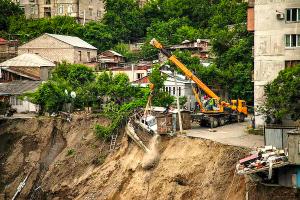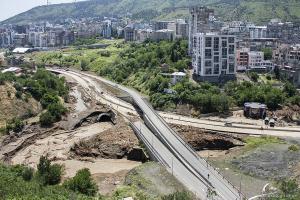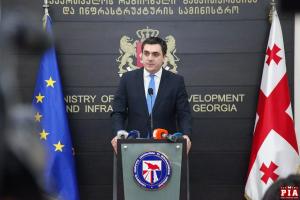Investment in Georgia: Flood relief and highways for a new partner
Georgia rebuilds after disastrous floods and sets up the infrastructure for improved trade
Late on the night of June 13, 2015, Ilia Darchiashvili drove through central Tbilisi in a downpour of rain. He hit traffic on Chabua Amirejibi Highway as he approached one of the bridges across the Vere, a tributary of the city’s main Mtkvari River. Darchiashvili turned his Toyota toward another crossing where cars weren’t stalled and went home to bed. “There was just heavy rain and a traffic jam. There was no perception that anything was about to take place,” he remembers.
“Then it happened.”
By the time Darchiashvili awoke, one million cubic metres of mud had slid into the Vere, damming it in two places. The river burst its banks, flooding the centre of Georgia’s capital. There were 19 dead and 22,000 of Tbilisi’s 1.1 million people were without electricity. Hippos and jaguars escaped from the zoo to roam the streets. One man was mauled to death by a tiger.
Darchiashvili, who was then manager of the Municipal Development Fund of Georgia, went into action alongside officials from Tbilisi city hall and other branches of the national government, organising aid to the disaster’s victims. “Our first goal was to make people safe,” says the 35-year-old, who is now the country’s vice minister of Regional Development and Infrastructure. “After that, all of us just focused on starting to rebuild. In parallel, we were looking for additional financial resources.”
Emerging from the mudslides
Among the quickest to react was the European Investment Bank, which has been ramping up investment in Georgia over the last couple of years. Last year, the EIB opened a regional office in Tbilisi, and by the end of 2016 the Bank expects to have loaned around EUR 1 billion to Georgia.
When news of the disaster reached bank officials in Luxembourg, the loan officer in the Public Sector Division team working with Georgia was already wrapping up another operation to upgrade the country’s municipal infrastructure. The team swiftly developed a second line of financing to be used to counter damage inflicted by the natural disaster.
Bank officials flew to Tbilisi the following week to start hammering out details. They found a city still crippled by flooding and mudslides. “Bridges and roads had collapsed,” recalls Georgia Koutsiana, the loan officer in charge of EIB Public Sector Operations in Georgia. “Normal life was really disrupted.”
Reconstruction financed
Although the investment in Georgia was only signed in February 2016, the national government had started rebuilding immediately in anticipation of further financing from the EIB as soon as negotiations were finalised. Engineers from the Bank’s Projects directorate provisionally reviewed and approved in advance a number of different reconstruction works.
The result is a EUR 100 million loan divided into two portions:
- EUR 50 million for flood relief
- EUR 50 million for municipal and tourism infrastructure
Most EIB loans amount to no more than half of the cost of a project. That’s because the Bank tries to encourage other investors to join, stretching its money as well as providing a stamp of approval. In the case of the emergency reconstruction credit facility offered to Georgia, the EIB will take on the full project cost, because it’s responding to a natural disaster.
Investment in Georgia for every citizen
The EIB’s intervention had considerable impact on the ground, as Georgia rebuilt. “Every citizen in our capital has been directly affected by this flood,” says Minister Darchiashvili. “The EIB emergency funds have reconstructed roads and infrastructure. They’re also being used to mitigate the risks of a repeat disaster in the future.”
Like the Bank, Europe is moving fast to develop closer relations with Georgia. In 2014 the EU signed an Association Agreement with Georgia, which does a quarter of its trade with European countries. The agreement foresees closer economic ties between Europe and Georgia, as well as reforms of Georgia’s economy.
The EIB investment in Georgia plays a key role in the country’s economic development. It’s also significant in Georgia’s plan to become a regional centre for trade, based in large part on its recent political stability.
Totalling EUR 700 million since 2010, the EIB’s loans have contributed handily to that stability:
- The EIB is funding several sections of an East-West highway (E60) that will connect Georgia’s border with Azerbaijan in the east with Batumi, the country’s port on the Black Sea. “The highway will be a vital stage of a new Silk Road,” says Koutsiana, the loan officer. The latest section is funded with a EUR 49.5 million loan signed in February 2016.
- The EIB finalised a EUR 100 million deal in October 2015 to rehabilitate the waste water network and construct a new waste-water treatment plant in Kutaisi, the country’s second-largest city.
Financing for Georgia…and across the region
That’s just part of the infrastructure Georgia needs to fulfil its economic promise. The EIB is at work on other requirements, too.
Take the border crossings with Armenia. Across the southern Caucasus, about 40 percent of transportation time is taken up with border procedures. The crossings were upgraded on the Georgian side a few years ago. But trucks still wait a long time to cross from the Armenian side of the border because of a lack of facilities there. With EUR 30 million in EIB funding, Armenia will unveil a state-of-the-art crossing facility this year, which will have the capacity to operate effectively even during peak traffic.
With these kinds of deals and more to come, it will be trade that flows fastest through Georgia, instead of the raging Vere River.



